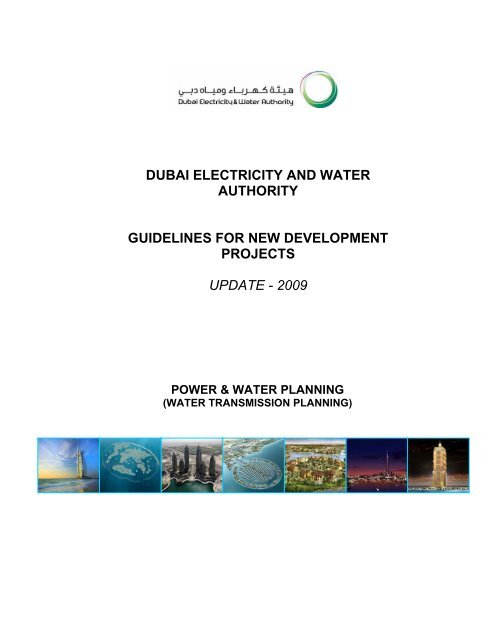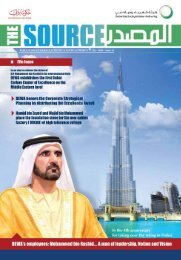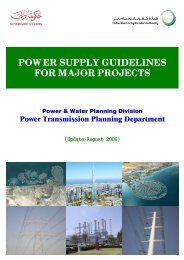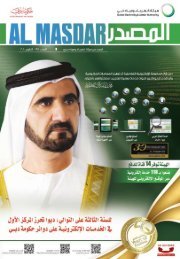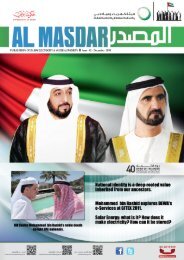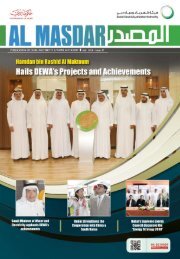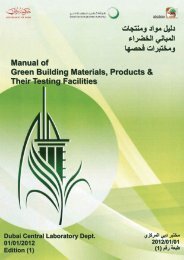Guidelines For New Development Projects -update 2009
Guidelines For New Development Projects -update 2009
Guidelines For New Development Projects -update 2009
- No tags were found...
You also want an ePaper? Increase the reach of your titles
YUMPU automatically turns print PDFs into web optimized ePapers that Google loves.
DUBAI ELECTRICITY AND WATER<br />
AUTHORITY<br />
GUIDELINES FOR NEW DEVELOPMENT<br />
PROJECTS<br />
UPDATE - <strong>2009</strong><br />
POWER & WATER PLANNING<br />
(WATER TRANSMISSION PLANNING)
DUBAI ELECTRICITY AND WATER AUTHORITY<br />
GUIDELINES FOR NEW DEVELOPMENT<br />
PROJECTS<br />
CONTENTS AMENDMENT RECORD<br />
This Document has been issued and amended as follows:<br />
Issue Revision Description Date Signed<br />
1 0 23/3/2008 Amany<br />
1 1 Updated as per DEWA<br />
<strong>New</strong> Organization<br />
08/07/<strong>2009</strong> Amany
1 INTRODUCTION<br />
The purpose of this document is to provide guidelines to developers and consultants<br />
on submitting project information for DEWA’s review and approval. The guidelines are<br />
intended to help in understanding DEWA requirements and facilitate the preparation<br />
of Master Plans for development projects and related documents.<br />
<strong>New</strong> development projects need to be carefully studied by DEWA in order to plan for<br />
meeting water demands and other system requirements, which may involve building<br />
new transmission and distribution networks, or even increasing production capacity.<br />
This document may be <strong>update</strong>d or amended as may be deemed necessary.<br />
2 WATER RESOURCES REQUIREMENTS<br />
Information on large developments with high demands that are likely to require<br />
planning for additional water resources (productions plants) must be submitted to<br />
DEWA at least 5 years prior to anticipated project commissioning date. (Lead time for<br />
the construction/development of water production facilities is 5 years).<br />
3 STORAGE RESEVOIRS:<br />
(a)<br />
Storage for DEWA system<br />
DEWA has a policy to maintain bulk storage of potable water equivalent<br />
to two days of system peak demand; the developers for major projects<br />
may be requested to provide land for bulk storage within their project,<br />
depending on project size.<br />
(b)<br />
Customers storages<br />
The local storage for individual premises should be able to cover<br />
average demand for at least 24 hours. Provision of adequate on-site<br />
water storage facilities should be considered by the developers.<br />
<strong>Guidelines</strong> for <strong>New</strong> <strong>Development</strong> <strong>Projects</strong><br />
1 of 8
4 PUMPING STATIONS<br />
Developers are required to provide existing and proposed site topography information<br />
based on actual survey data in order to establish any pumping requirements. Higher<br />
grounds in the water transmission system might require the installation of booster<br />
pumping stations for which the standard planning and construction lead time is 2-3<br />
years before commission.<br />
Occasionally, developers and their consultants may be required to consider booster<br />
stations to supply water to higher grounds where presence of relatively low pressures<br />
would result in inadequate supply within the development.<br />
5 TRANSMISSION SYSTEM<br />
DEWA’s water system consists of a transmission network where pipe diameters<br />
range from 550 mm to 1200 mm, and distribution network where pipe diameters<br />
range from 100 mm to 450 mm.<br />
The approved pipe materials currently used by DEWA for the water transmission<br />
network are:<br />
• Fibre-cement (FC) pipe CLASS 18 /24 ( subject to DEWA’s approval)<br />
• Glass fibre Reinforced Epoxy (GRE)<br />
• All fittings (including bends, tees, reducers and flanges) used with FC<br />
and GRE water pipelines shall be of GRE material complying with<br />
DEWA’s specifications.<br />
<strong>Development</strong> of water transmission pipeline requires a lead-time of 3-4 years before<br />
completion (depending on the line length). Therefore, developers or their consultants<br />
are required to submit design details of the internal network in time for DEWA’s<br />
review and approval.<br />
6 DISTRIBUTION SYSTEMS<br />
The Distribution System is planned and developed in parallel with the project’s<br />
development only within road right-of-ways for which the final designs are approved<br />
and levelled accordingly. Lead time for water distribution network development is 2-3<br />
years before commission (depending on the network area coverage).<br />
Developer must submit his internal network design for DEWA’s study and approval.<br />
Pipe materials currently adopted are FC & GRE subject to DEWA’s approval.<br />
<strong>Guidelines</strong> for <strong>New</strong> <strong>Development</strong> <strong>Projects</strong><br />
2 of 8
7 SYSTEM MONITORING<br />
Depending on the nature and size of the project’s network, developers may be<br />
required to install monitoring devices at main connection locations as per DEWA’s<br />
specifications.<br />
7.1 Bulk Flow Metering<br />
Bulk flow meters are essential for measurement and flow<br />
monitoring within the transmission and distribution systems. Bulk<br />
flow meters will be proposed at selected sites as per DEWA’s<br />
specifications.<br />
7.2 Pressure Transmitters<br />
Pressure gauges and transmitters may be required as per<br />
DEWA’s specifications to monitor pressures at locations<br />
selected by DEWA.<br />
7.3 Water Quality Controls<br />
Analyzer stations consisting of transmitters and sensor<br />
assemblies for measuring pH, residual chlorine, conductivity and<br />
temperature may be installed at specified location as per<br />
DEWA’s specifications.<br />
7.4 Water SCADA requirements<br />
DEWA’s requirements for integrating the newly developed<br />
network of major projects with DEWA’s SCADA system should<br />
be discussed and approved by DEWA’s <strong>Projects</strong> Dept. /<br />
Operation and Maintenance Dept.<br />
8 SERVICE CONNECTIONS<br />
As per DEWA’s policy, separate house connection pipes in all premises should be<br />
metered. In case of buildings, a main meter is installed on the main inlet pipe before<br />
the under-ground storage tank and sub-meters are installed on the roof of the building<br />
on the discharge side of the elevated storage tanks. Developers should provide house<br />
connections, proposed layouts and materials used for DEWA’s approval.<br />
<strong>Guidelines</strong> for <strong>New</strong> <strong>Development</strong> <strong>Projects</strong><br />
3 of 8
9 WATER DEMAND<br />
As demand and its phasing represent the most crucial element for the whole water<br />
transmission network planning process, developers are required to provide timely<br />
submission of the following information to DEWA:<br />
1. Reasonably Projected Demand Figures along with yearly phasing up to<br />
ultimate build-out, occupancy phasing until 100% is achieved and phasing by<br />
percentage of land used.<br />
2. Reasonable Demand Phasing throughout the development planning period.<br />
Each planning phase should be represented by commissioning dates rather<br />
than construction start dates. <strong>For</strong> Mega <strong>Projects</strong>, information for each phase<br />
should include the relevant small projects and their demands.<br />
3. There are six major demand categories established for DEWA system:<br />
• RESIDENTIAL<br />
• COMMERCIAL<br />
• GOVERNMENT & PUBLIC PREMISES<br />
• INDUSTRIAL<br />
• LABOUR CAMPS<br />
• DISTRICT COOLING – water not provided by DEWA for new projects<br />
Developers should as reasonably as possible map project demand types with DEWA<br />
established demand categories. This is required in order to facilitate incorporating the<br />
same into the demand forecast process.<br />
4. Base information and calculations used to determine the water demands such<br />
as population, land use and district cooling estimates.<br />
5. DEWA does not supply potable water for:<br />
a. Construction purposes (particularly if there is no existing developed<br />
network at the project area).<br />
b. Water features (lagoons, etc.).<br />
c. Irrigation / landscape purposes.<br />
d. District cooling water for new projects (in compliance with Executive<br />
Order No.27).<br />
<strong>Guidelines</strong> for <strong>New</strong> <strong>Development</strong> <strong>Projects</strong><br />
4 of 8
10 PEAKING FACTOR<br />
A peaking factor in the range of 1.2 - 1.5 should be used to accommodate for the daily<br />
variation in demand. This factor will vary depending on the nature of the development<br />
and is driven by the demand categories adopted.<br />
11 DEMAND REQUIREMENTS<br />
The following Table outlines general typical ranges of water consumption (rates which<br />
may be used as a guide for calculating water demands for development projects.<br />
However, the consultant / developer should accurately calculate the demand required<br />
with due consideration to the nature of the development project.<br />
CATEGORY<br />
Demand Range<br />
(L/Cap. Day)<br />
RES. BUILDINGS 250-400<br />
COMMERCIAL BUILDINGS 60-100<br />
VILLAS 250-400<br />
LABOUR ACCOM./ WORKERS 80-150<br />
RESTAURANT (per meal)<br />
10-15 l/d per meal<br />
MOSQUES 10-60<br />
HOTELS (per room including workers, visitors) 300-500<br />
WORKSHOPS/ MACHINERY 60<br />
SHOPS 60-80<br />
OFFICES 60-80<br />
SCHOOLS 60-80<br />
PUBLIC AMENITIES 10-60<br />
RETAIL 60-80<br />
VISITORS 14-45<br />
MIXED USED (Commercial) 60-80<br />
MIXED USED (Residential) 250-400<br />
ENTERTAINMENT AND LEISURES 60<br />
THEATER 10-60<br />
TOWN CENTER 60-80<br />
MEDICAL (per bed) 60-80<br />
HEADQUARTERS 60-80<br />
UNIVERSITY 60-80<br />
LABORATORY 60-80<br />
MANUFACTURING 60-80<br />
BASED METAL CHEMICAL ZONE 100<br />
LOGISTIC, ACADEMIC & BUSINESS ZONE 60-80<br />
MINERALS 80<br />
NURSERY 60-80<br />
LOCAL PLAZA 60-82<br />
OTHER 60-82<br />
EVENTS 10-60<br />
GUARDHOUSE 60-80<br />
CLUBHOUSE/SWIMMING POOL 100<br />
Source: Standard practises and submitted master plans for major developments.<br />
<strong>Guidelines</strong> for <strong>New</strong> <strong>Development</strong> <strong>Projects</strong><br />
5 of 8
12 NETWORK DESIGN CRITERIA AND<br />
HYDRAULIC MODELING<br />
<strong>For</strong> every developer network models should be the basis for network design, including<br />
pipe sizing, layout, and connectivity.<br />
DEWA’s Water Network design criteria are based on previous experience and on<br />
recommendations by material manufacturers. The following criteria should be<br />
considered by developers during the hydraulic analysis for network design:<br />
• Maximum Pipeline Velocity is 1.0 m/s for Distribution lines & 1.5 m/s for<br />
Transmission lines. [Design velocity for distribution and transmission main<br />
should also be specified]<br />
• Minimum Pressure: 1 Bar at highest point within the developer network.<br />
• Maximum Pressure: 4 Bar at lowest point within the Transmission network.<br />
• A minimum number of connections should be adopted for better network<br />
management. Pressures assumed at connection points should satisfy the<br />
design criteria above for the adopted network layout. However, these<br />
pressures will be reviewed by DEWA and changes if necessary will be<br />
recommended as appropriate, including additional pumping or pressure<br />
reduction requirements.<br />
• Zoning and pressure control of the network if applicable should be considered.<br />
• The model demand should correspond to the figures submitted in the demand<br />
sheets.<br />
• The developer or their consultant is expected to submit peak hour Network<br />
Models for each main phase of the development as applicable.<br />
• Models should be in EPANET or any other compatible software.<br />
• Network Models should be geo-referenced to the actual physical location<br />
coordinates using the standard DM coordinate system known as “DLTM”.<br />
• If the development expands through major phases, it is required to submit<br />
separate models representing each phase.<br />
• DEWA will review the models in contrast with its requirements and planning<br />
information, and recommendation for changes will be made accordingly.<br />
• The network layout should consider looping the system wherever possible for<br />
better water circulation and system reliability.<br />
<strong>Guidelines</strong> for <strong>New</strong> <strong>Development</strong> <strong>Projects</strong><br />
6 of 8
13 REQUIRED DOCUMENTS:<br />
Developers or their consultants should submit the following documents for the review<br />
of Planning Water Transmission Department.<br />
Addressed to:<br />
Mr. Yousef Jebril.<br />
Executive Vice President – Power & Water Planning<br />
P.O. Box 564<br />
Dubai, U.A.E.<br />
Fax 04-3249206<br />
1 Hard copy of the Location map and layout of the project as well as soft copy in<br />
CAD or shapefile format in DLTM coordinate system.<br />
2 A Master plan study for the project.<br />
3 Project’s water demand calculation, total demand phased year wise, plot /<br />
zone wise demand - all calculations should be provided in MS Excel (1997-<br />
2003) format spreadsheet along with supporting files.<br />
4 Land use demand calculations including % of land use types and year wise %<br />
of occupancy envisaged by the developer.<br />
5 Factors used to calculate Average as well as Peak Demand along with the<br />
justification of the factors used.<br />
6 Statement of availability of plots / corridors as per DEWA requirements.<br />
7 Digital as well as hard copies of internal network design.<br />
8 Hydraulic modelling file(s) developed for the network geo-referenced to the<br />
actual coordinate system (DLTM)<br />
Upon receipt Water Transmission Planning Approval for submitted water demands<br />
and main connections, developers or their consultants should submit the following<br />
information to DEWA’s water projects Department approval:<br />
Addressed to:<br />
Mr. Branly Nassour.<br />
Vice President - Water <strong>Projects</strong> & Engineering<br />
P.O. Box 564<br />
Dubai, U.A.E.<br />
Fax 04-3244922<br />
1 Project’s demands table as approved by Water Transmission Planning Dept.<br />
2 Expected date of connection to DEWA main lines.<br />
<strong>Guidelines</strong> for <strong>New</strong> <strong>Development</strong> <strong>Projects</strong><br />
7 of 8
The following is to be observed during the project’s network design:<br />
1. <strong>For</strong> pipes of 450 mm dia. and above, butterfly valves (BFV) should be used &<br />
gate valves (GV) should be used for pipes less than 450 mm in diameter. <strong>For</strong><br />
BFV of 450 mm, chamber > 1.75 meter must be noticed in corridors and depth<br />
from F.R.L to the crown of top level 450 mm pipe = 1.50 meter mimimum.<br />
2. Road Cross-Sections (Distance = 0.9 to 1.2 from B.L till C.L. of water pipes for<br />
distribution, details of DEWA corridor if any & also details of connection with<br />
DEWA main lines & corridor for this connection (cross section)<br />
3. Check locations of valves distributed along network to suit operation and<br />
Maintenance standards.<br />
4. Space between valves along straight lines should be from 500 to 1000 m, air<br />
valves 800 m and wash out valves 1500 m.<br />
5. Provide corridors for pipes in the following order<br />
i. 5 meters for 1200 mm & 900 mm pipes<br />
ii. 3 meters for 600 mm pipes<br />
iii. 1.75 meters for 450 mm pipes<br />
iv. 1 meter for less than 450 mm pipes.<br />
6. Valves or fittings should never be placed under carriage way.<br />
7. Water lines shall not be under carriage way or parking areas.<br />
8. Approximate location of the house connections should be shown on the<br />
drawings.<br />
9. Clear notice on the drawings saying that air valves locations will be in highest<br />
locations (for transmissions lines only) & wash out valves will be in low<br />
locations as per site conditions & engineer’s decision however, wash out<br />
valves should be always shown on drawings at end cap location.<br />
10. BOQ for NOC with related drawings attached as per DEWA standards.<br />
<strong>Guidelines</strong> for <strong>New</strong> <strong>Development</strong> <strong>Projects</strong><br />
8 of 8


